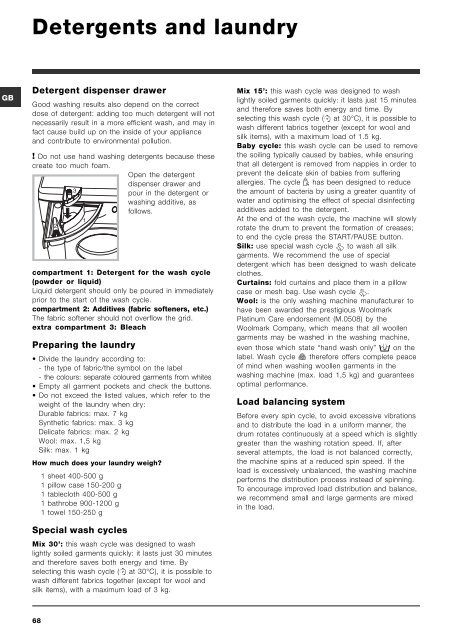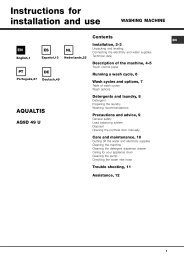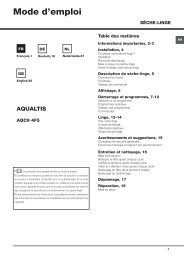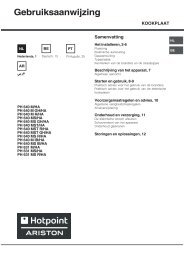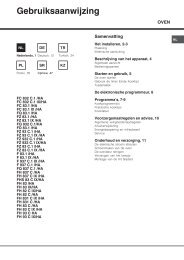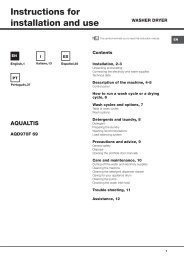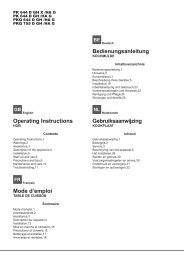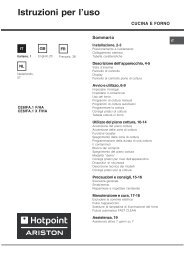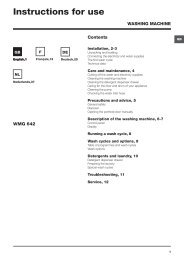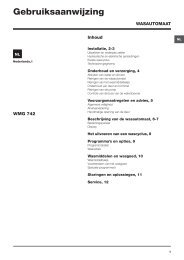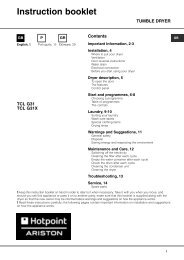Download handleiding - Hotpoint
Download handleiding - Hotpoint
Download handleiding - Hotpoint
Create successful ePaper yourself
Turn your PDF publications into a flip-book with our unique Google optimized e-Paper software.
MAX<br />
Detergents and laundry<br />
GB<br />
Detergent dispenser drawer<br />
Good washing results also depend on the correct<br />
dose of detergent: adding too much detergent will not<br />
necessarily result in a more efficient wash, and may in<br />
fact cause build up on the inside of your appliance<br />
and contribute to environmental pollution.<br />
! Do not use hand washing detergents because these<br />
create too much foam.<br />
Open the detergent<br />
dispenser drawer and<br />
3<br />
pour in the detergent or<br />
washing additive, as<br />
follows.<br />
1<br />
2<br />
compartment 1: Detergent for the wash cycle<br />
(powder or liquid)<br />
Liquid detergent should only be poured in immediately<br />
prior to the start of the wash cycle.<br />
compartment 2: Additives (fabric softeners, etc.)<br />
The fabric softener should not overflow the grid.<br />
extra compartment 3: Bleach<br />
Preparing the laundry<br />
• Divide the laundry according to:<br />
- the type of fabric/the symbol on the label<br />
- the colours: separate coloured garments from whites<br />
• Empty all garment pockets and check the buttons.<br />
• Do not exceed the listed values, which refer to the<br />
weight of the laundry when dry:<br />
Durable fabrics: max. 7 kg<br />
Synthetic fabrics: max. 3 kg<br />
Delicate fabrics: max. 2 kg<br />
Wool: max. 1,5 kg<br />
Silk: max. 1 kg<br />
How much does your laundry weigh?<br />
1 sheet 400-500 g<br />
1 pillow case 150-200 g<br />
1 tablecloth 400-500 g<br />
1 bathrobe 900-1200 g<br />
1 towel 150-250 g<br />
Special wash cycles<br />
Mix 30’: this wash cycle was designed to wash<br />
lightly soiled garments quickly: it lasts just 30 minutes<br />
and therefore saves both energy and time. By<br />
selecting this wash cycle ( at 30°C), it is possible to<br />
wash different fabrics together (except for wool and<br />
silk items), with a maximum load of 3 kg.<br />
Mix 15’: this wash cycle was designed to wash<br />
lightly soiled garments quickly: it lasts just 15 minutes<br />
and therefore saves both energy and time. By<br />
selecting this wash cycle ( at 30°C), it is possible to<br />
wash different fabrics together (except for wool and<br />
silk items), with a maximum load of 1.5 kg.<br />
Baby cycle: this wash cycle can be used to remove<br />
the soiling typically caused by babies, while ensuring<br />
that all detergent is removed from nappies in order to<br />
prevent the delicate skin of babies from suffering<br />
allergies. The cycle has been designed to reduce<br />
the amount of bacteria by using a greater quantity of<br />
water and optimising the effect of special disinfecting<br />
additives added to the detergent.<br />
At the end of the wash cycle, the machine will slowly<br />
rotate the drum to prevent the formation of creases;<br />
to end the cycle press the START/PAUSE button.<br />
Silk: use special wash cycle to wash all silk<br />
garments. We recommend the use of special<br />
detergent which has been designed to wash delicate<br />
clothes.<br />
Curtains: fold curtains and place them in a pillow<br />
case or mesh bag. Use wash cycle .<br />
Wool: is the only washing machine manufacturer to<br />
have been awarded the prestigious Woolmark<br />
Platinum Care endorsement (M.0508) by the<br />
Woolmark Company, which means that all woollen<br />
garments may be washed in the washing machine,<br />
even those which state “hand wash only” on the<br />
label. Wash cycle therefore offers complete peace<br />
of mind when washing woollen garments in the<br />
washing machine (max. load 1,5 kg) and guarantees<br />
optimal performance.<br />
Load balancing system<br />
Before every spin cycle, to avoid excessive vibrations<br />
and to distribute the load in a uniform manner, the<br />
drum rotates continuously at a speed which is slightly<br />
greater than the washing rotation speed. If, after<br />
several attempts, the load is not balanced correctly,<br />
the machine spins at a reduced spin speed. If the<br />
load is excessively unbalanced, the washing machine<br />
performs the distribution process instead of spinning.<br />
To encourage improved load distribution and balance,<br />
we recommend small and large garments are mixed<br />
in the load.<br />
68


